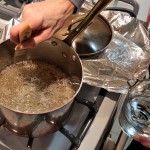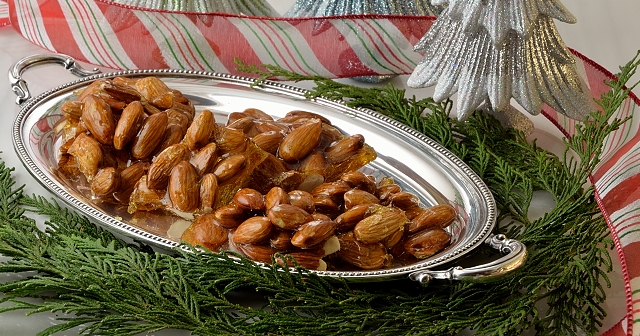Croccante di Natale – Almond Brittle for Christmas
Croccante di Natale or Croccante di mandorle (Almond Brittle) is Abruzzo’s classic Christmas confection. You will find it in every Abruzzese home, on every dessert table and under every Christmas tree. My grandmother, Angela Barra Crocetti, made Croccante throughout the Christmas season. With the American holiday of Thanksgiving behind her, she went to work shelling bag after bag of fragrant almonds. I have never smelled almonds like the ones she used, and to this day I do not know where she bought them. As magnificent as the almonds smelled in their burlap bags, their true wonder was revealed as they toasted in her oven. Even still the perfume of roasting almonds transports me back to her kitchen.
Croccante di Mandorle is a shiny, crunchy almond confection, much like our golden American Peanut Brittle, but the sugar for Croccante is cooked to a far darker stage, a sumptuous amber. The confection is cooled, cut into diamond shapes or broken into pieces. A shard of Croccante in a scoop of ice cream makes a particularly striking dessert. This sugary confection can also be chopped or pulverized in the food processor and used as a topping for frozen desserts, a flavoring for cannoli filling or other treats. Feel free to use any nut you like; hazelnuts (toasted and skinned) are a particularly nice choice, but at Christmas in Abruzzo this candy is all about almonds.
Before we begin – a few caveats about working with sugar. Do not leave the room while the sugar is cooking. Although the temperature climbs slowly at first, once it begins to color, things happen rapidly, and the smoke from burned sugar will set off your fire alarm. This I know. Second, burns from hot sugar can be devastating; before you begin, fill a medium bowl with ice water. This is for you to plunge you hand in should you be burned. And last, banish pets and kids from the kitchen. Safety first.
Your goal in making Croccante is to break down and control the crystalline structure of the sugar ending up with a brown liquid that is 100% sugar in suspension. You will boil away all of the water. You may see recipes that call for the addition of corn syrup or an acid, such as lemon juice, so called “interfering agents” to aid in controlling the formation of crystals. The classic Abruzzese recipe calls for sugar, nuts and a bit of water, plus a lemon for the very last step. That’s all. To keep on the right side of tradition and crystal formation, just follow a couple of simple tips. You must first dissolve the sugar completely by heating it with water. During this process some of the mixture may splash onto the sides of the pan. The water will evaporate and you will be left with the dreaded crystals – dissolve them or they will fall back into the pan, and act as “seed” crystals, triggering formation of more crystals and ruining your confection. To dissolve the pesky crystals you can either use a pastry brush dipped in water or cover the pan with a tight fitting lid for 3 to 4 minutes to wash down any crystals that have accumulated.
During this process some of the mixture may splash onto the sides of the pan. The water will evaporate and you will be left with the dreaded crystals – dissolve them or they will fall back into the pan, and act as “seed” crystals, triggering formation of more crystals and ruining your confection. To dissolve the pesky crystals you can either use a pastry brush dipped in water or cover the pan with a tight fitting lid for 3 to 4 minutes to wash down any crystals that have accumulated.
As the sugar heats and cooks it will pass through the various stages of candy making – soft ball, hard ball, etc. finally reaching and passing the hard crack stage (310 degrees) and moving into the world of caramel, pure sugar. As the sugar heats it may not color evenly, usually due to hot spots in your pan or burner. Gently swirl the pan to ensure even cooking. Stirring or shaking the pan at this point will also create crystals, the enemy of a smooth, glassy Croccante.
You are looking at pure sugar in suspension – no water at all. It will appear to have 2 layers of bubbles. Watch carefully. Your original pan of sucrose has now begun to break down into different compounds, all of which contribute to the rich flavor and amber color. It will have taken you over 15 minutes to get to this point, but now the crucial time is upon you. Trouble is, there is a point of no return. Cook this mixture too long, and it will burn (350 degrees and up), at which point it is irretrievable. (Should you burn the sugar, set the pan aside to cool briefly, fill it with water, and set over a medium flame to melt the sugar. You can then clean your pan with ease.)
Remember, the sugar mixture is extremely hot, well over 300 degrees, so even after you have removed it from the heat, it will continue to cook. Work quickly as you add the warm nuts, stirring gently to coat them, and pouring the mixture onto the prepared sheet, scraping the pan as little as possible – those pesky crystals again.
Croccante di Natale
butter or almond oil to grease sheet pan
3 cups sugar
1/2 cup water
3 cups whole unblanched almonds
lemon, cut in half
Preheat oven to 325 degrees.
Grease or butter a large sheet pan. Set aside.
Spread almonds on a large rimmed baking sheet, and toast on middle rack of oven 8 to 10 minutes or until fragrant, stirring 2 or 3 times. Remove from oven, and set aside.
Meanwhile, combine water and sugar in a 4 quart saucepan, and cook over medium-low heat to dissolve sugar completely, stirring occasionally, about 6 to 7 minutes. Use a pastry brush dipped in water or cover with a tight fitting lid for 3 to 4 minutes to wash down crystals from sides of pan.
Increase heat to medium and continue cooking, swirling pan occasionally, until the sugar has taken on an amber color, about 15 minutes more. Remove from heat and add warm almonds, tossing gently to evenly coat the nuts.
Pour mixture onto prepared sheet, scraping pan as little as possible. Rub half a cut lemon over the confection to flatten it. Cut into diamond shapes while still warm or cool completely, and break into shards. Store in airtight container at room temperature.
Note: You can click on any picture for a larger image, and to see a slide show!
I have no affiliation with any product, manufacturer, or site mentioned in this article.






Wednesday, December 14th 2011 at 12:01 am |
Every year I have an ambition about making croccante, but I never get round to it. Thanks for spurring me on.
Wednesday, December 14th 2011 at 9:33 am |
Ciao Mette,
I say go for it! The first few times I tried it alone, I cooked the sugar for too long. It smoked, and I do mean a lot. It was pretty funny, actually. But after a while you will get a feel for this. Make it once, and if you are not happy with the color of your caramel, or if it crystallizes, make it again right away. That way you will clearly remember what you did the first time, and the technique will become very clear. Just remember – stir only occasionally at first as you are dissolving the sugar. Once the sugar has completely dissolved, and only then, you can up the heat and go for the caramel. And I was not exaggerating about how hot this is. If you get some on your skin, it will stick, and that is the real danger – that’s the rationale for having the ice water ready at hand – again, I speak from experience. Croccante is rewarding to make, and people always love to receive it a a gift. It just says “Christmas is here.” Buy some sugar and almonds, and let me know how it goes – I would love to have a photo for my Readers’ Gallery. But as I said, if at first you don’t succeed, try again, right away. You can do this, just keep at it. In one session you will have mastered the technique.
Thursday, December 15th 2011 at 10:17 am |
I love almonds and this recipe is just delicious.
Thursday, December 15th 2011 at 9:31 pm |
Ciao Anthony,
I figure this recipe has it all – nutritionists tell us that almonds are the ultimate snack food, the healthiest nut. Combine the almonds with caramel – this is manna from heaven. I am glad you like it. Thanks for stopping by and Buon Natale!
Friday, December 16th 2011 at 9:59 am |
Well, is there a better treat than this? I fear that if I make this it will never leave my kitchen!! It sounds delicious.
Friday, December 16th 2011 at 1:24 pm |
Ciao Toni,
Croccante sure is good, and it does seem to go awfully fast. Even Bart, who is not a major sweet fan enjoys it. And what a nice gift for Christmas, or anytime of year, for that matter. The amber shards filled with almonds are quite dramatic. In a glass jar, it makes a gorgeous presentation. Buon Natale!
Sunday, December 18th 2011 at 9:49 pm |
Love your pictures! I saw the first picture on latimes.com.
Sunday, December 18th 2011 at 11:24 pm |
Ciao Natty,
Benvenuta! And thank you for the kind words. I am so glad you enjoy the photographs. I have fun with this, and most especially I enjoy sharing it with others. Thank you so much for visiting. I hope you stop by often!
Friday, December 6th 2013 at 7:56 am |
This is beautiful! And yes please to having it over ice cream! Your detail is always perfect and I guess I should’ve listened better in Chemistry class…
Friday, December 6th 2013 at 8:13 am |
Hi Laney,
The deal is that we all should have listened better! I bet we would all have been riveted had the teacher explained these various changes while demoing something like this. Ditto for denaturing protein; make a meringue to show how agitating a protein can denature it. I think those teachers missed the boat with us food lovers.
Saturday, December 6th 2014 at 2:44 pm |
Great recipe Adri. This is the way I made croccante with my mon. I love it!
Saturday, December 6th 2014 at 3:29 pm |
Ciao Paola,
I hope this one brought back memories. It is so good to eat. We had it only at Christmas, so it was really something special for us. Make some this year!